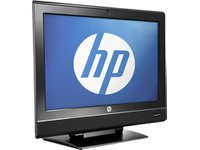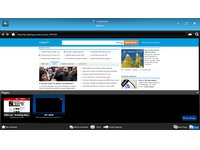Touchscreen Computing: Gateway ZX4931 And HP TouchSmart 310
HP TouchSmart 310 (310-1125y)
Unlike Gateway, HP sells all-in-ones with and without touchscreens. All of them share the same basic physical design: a glossy LCD framed against a black piano finish. This is what you get with the TouchSmart 310 ($699).



The display is well-balanced. HP weighs the base down with a plastic-covered steel plate that has the appearance of brushed aluminum. This improves stability by lowering the center of gravity, making this computer suitable for any surface and environment, including high-traffic areas.
As expected, most of the connectivity is located behind the system's screen. But two USB ports on the left side and audio ports on the right side offer easy accessibility. The sound bar is located just below the display. The quality of HP's speakers isn't anything to get excited over, but they provide fairly even sound distribution.


There's a recurring theme that we're noticing with all-in-ones: poor display controls. There are more options on the TouchSmart 310 than you get with Gateway's ZX4931, but you have to adjust the settings through HP's proprietary software. While HP achieves an aesthetic design void of all buttons (with the exception of power), it comes at the cost of utility. Unless you go through the software, there isn't even a way to change brightness.
Touchscreen
When it comes to actual use, the TouchSmart 310 is a bit more responsive to zoom commands, but rotating requires more deliberate one-handed gestures. You can see for yourself in the demo video.


The simplicity of Gateway's TouchPortal software is what we love. But unfortunately, fewer applications are optimized for use with Gateway's touchscren. In contrast, HP TouchSmart interface is full of options and includes apps for weather, resource monitoring, eBay, Facebook, Hulu, Netflix, note-taking, and even a recipe program.
Get Tom's Hardware's best news and in-depth reviews, straight to your inbox.
HP provides ten videos for anyone unfamiliar with how to use those applications, and we posted all of them to our YouTube account. As a preview, you can watch the first tutorial below.
Current page: HP TouchSmart 310 (310-1125y)
Prev Page Gateway One ZX4931 (ZX4931-31e) Next Page Size Profile-
compton This article was worth what I can only assume was a torturous trip to Best Buy. But curiously, I'm not thinking about all in ones, but rather touch screens. Dell makes an eIPS panel with a touch screen for not a ridiculous sum of money. I've been considering it for a foray into touch screen computing on my desktop where I have the juice to do it right.Reply
Toms strikes another blow against boring reviews. Good job. -
flong Interesting subject - could this really be the computer's future? I don't think that the keypad will be replaced until voice control is more mature.Reply -
Voice control is not the future; it's been around forever. Until computers can think, you can't talk to them.Reply
In reference to the article, while desktop DIY rigs are definitely orientated to serve a central purpose, these all-in-ones are just as purpose built to serve an environment. (eg kitchen, living area)
Make touchscreens more seamless. By seamless I mean cheap. Where is the touch screen film I can just roll over whatever I want? How about a coffee table that recognizes my devices and my Heineken? -
flong Voice control has been around forever - duh. Brilliant observation. And while we are making observations, there is at least one computer you can talk to, IBM's Watson, which won jeopardy. Quality voice control is just coming into being.Reply
What I meant was that until we have better voice control / input, a keypad will be necessary because typing on a vertical touchscreen, which is obviously awkward, would not suffice to do say a high school homework assignment.
Even with better voice input there may be some physical interface like a mouse. Right now cutting edge voice control for consumers is what we find with Ford's "Sync." But that would not work for a work station.
Touch screens like the Ipad have their strengths but nobody thinks they will replace computers with keyboards (nettops excepted).
However, if we have a "Watson" interface where we can provide input via voice control: that is the future of computers. With Watson you could virtually ask it to do any function, search any website or dictate a spreadsheet to it. Per your example, you could ask Watson to make your coffee and then put the morning newspaper on the built-in LCD coffee table viewer, turn the AC down to 75 degrees and find out what traffic is for the morning commute and it would be cable of doing all these things with voice input only. Bill Gates's home has many of these functions without an AI interface. -
I hate touch screens, bringing it to the PC just annoys me, I dont want to touch my screen, do not see a use for it...Reply
The next step forward is voice control that works! -
cknobman This article is one of the worst I have ever seen on Toms Hardware. It seems rushed, is missing tons of relevant information, and basically skims over the most important features of a touchscreen computer.Reply -
On the HP display ... is it 20" and ??? as on the lead page or is it 23" and 1600x900 as on the Display Spec page ? Because HP says it's 20" and a 1080P display for the 310 series.Reply
-
molo9000 Touch screens on desktops are an ergonomical nightmareReply
Just point your finger at your display for a while. Your arm will start hurting after about 2 minutes. -
acku MacTheKnifeOn the HP display ... is it 20" and ??? as on the lead page or is it 23" and 1600x900 as on the Display Spec page ? Because HP says it's 20" and a 1080P display for the 310 series.Reply
Fixed! -
acku cknobmanThis article is one of the worst I have ever seen on Toms Hardware. It seems rushed, is missing tons of relevant information, and basically skims over the most important features of a touchscreen computer.Reply
If you want to see something specifically please let us know. If there is one thing missing, it's more discussion on software/touchscreen demos, but we provided these as videos. And, as this is Tom's Hardware not Tom's software, we wanted to focus on the hardware.




